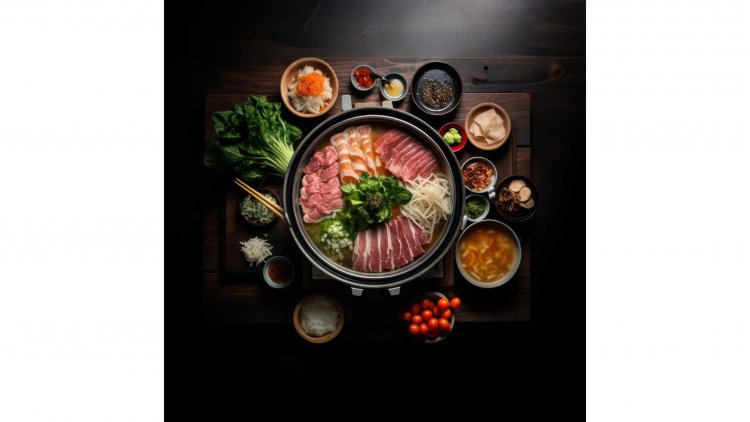Shabu-Shabu Extravaganza: Dive into Japan’s Flavorful Hot Pot Adventure
Embark on a culinary journey to Japan with this vibrant and interactive dish known as Shabu-Shabu. Translating to "swish-swish," Shabu-Shabu is not just a meal—it's a delightful experience that turns eating into a fun and communal activity. This Japanese hot pot dish is a feast for both the eyes and the palate, combining thinly sliced meat, fresh vegetables, and a savory broth that’s perfect for dipping and cooking.

Essential Ingredients for Shabu-Shabu
Creating the perfect Shabu-Shabu involves careful selection of ingredients to ensure a balanced and flavorful meal. Here’s what you’ll need:
For the Broth:
- 6 cups dashi stock: This Japanese soup base can be made from kombu (seaweed) and bonito flakes or purchased pre-made.
- 1/4 cup soy sauce
- 2 tablespoons mirin: A sweet rice wine that adds a touch of sweetness and depth to the broth.
- 1 tablespoon sake: Japanese rice wine that adds complexity to the flavor profile.
For the Meat:
- 1/2 pound beef sirloin or ribeye: Thinly sliced against the grain. You can ask your butcher for Shabu-Shabu cuts or slice the meat yourself at home.
- 1/2 pound pork loin or belly: Also thinly sliced for quick cooking.
For the Vegetables:
- 1 cup napa cabbage: Chopped into bite-sized pieces.
- 1 cup mushrooms: Shiitake, enoki, or oyster mushrooms work beautifully.
- 1 cup spinach: Fresh and cleaned.
- 1 cup sliced carrots: Thinly sliced for even cooking.
- 1 cup tofu: Firm or extra-firm, cut into cubes.
For Dipping Sauces:
- Ponzu sauce: A citrus-based soy sauce for a tangy flavor.
- Sesame sauce: Rich and nutty, perfect for dipping.
- Grated daikon radish: For added texture and freshness.
Preparing the Broth
Start by preparing the broth, the heart of Shabu-Shabu. If using homemade dashi, simmer kombu in water for 10 minutes, then remove it and add bonito flakes. Let it steep for another 5 minutes, then strain. If using store-bought dashi, heat it gently in a large pot. Add soy sauce, mirin, and sake, adjusting the quantities to taste.
Preparing the Meat and Vegetables
For the meat, thinly slice your beef and pork, ensuring the slices are as thin as possible to cook quickly in the hot broth. Arrange them neatly on a platter.
Prepare the vegetables by washing and cutting them into appropriate sizes. You want the pieces to be manageable for dipping and cooking quickly. Arrange them in separate bowls or platters.
Setting Up Your Shabu-Shabu Hot Pot
Choose a portable stove or induction burner for your dining table. Place a large pot in the center and bring the prepared broth to a simmer. Keep the broth hot but not boiling to ensure delicate cooking.
Cooking and Eating Shabu-Shabu
To cook, each person picks up slices of meat and vegetables using chopsticks or a small ladle and swishes them in the simmering broth. The thin slices of meat cook in just seconds, while vegetables may take a little longer depending on their thickness. Once cooked to your liking, dip the meat and veggies into your chosen sauces.
Tips for an Authentic Experience:
- Cook in batches: Avoid overcrowding the pot to maintain a consistent temperature.
- Use chopsticks: Traditionally, Shabu-Shabu is enjoyed with chopsticks, adding to the authentic experience.
- Monitor the broth: Keep an eye on the broth level and add more as needed to ensure it doesn’t run dry.
Enjoying Your Meal
Shabu-Shabu is as much about the process as it is about the meal itself. Enjoy the interactive nature of cooking at the table and savor the flavors of the broth, meat, and vegetables as they meld together. Don’t forget to sample different dipping sauces and enjoy the crispy textures of the freshly prepared ingredients.
Overall, Shabu-Shabu is an exceptional way to gather with friends and family around the table. It’s not just a meal but a shared experience that combines fresh ingredients with communal fun. Dive into this Japanese hot pot adventure and discover why Shabu-Shabu remains a beloved dish in Japanese cuisine.
Disclaimer: The recipes shared on this blog are intended for informational and entertainment purposes only. We do our best to ensure accuracy, but ingredient and preparation variations can alter results. Please use caution and consult a medical professional if you have dietary restrictions or health concerns. The blog and its authors are not liable for any adverse effects or consequences resulting from the use of the recipes provided. Always prioritize your health and safety when cooking.
What's Your Reaction?





















